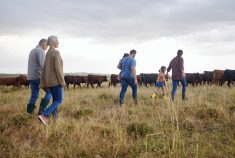In central Manitoba, a couple we’ll call Harry, 80, and Mary, 76, had a mixed grain and beef cattle farm for four decades. They sold the home quarter to their youngest son, taking back a long-term mortgage with favourable terms. They kept 320 acres, which they have rented out to a neighbour.
Their plan was to pay modest amounts of income tax each year rather than trying to postpone the most tax possible until death, when all deferred proceeds outside of Tax-Free Savings Accounts (TFSA) would be vulnerable to tax. The rate would be 50 per cent or more if one adds in deferred income.
Read Also

Gentle treatments for pain in the neck
Heading toward year-end, people unknowingly tense up against the cold and busyness, causing neck pain that can often be treated with appropriate support and gentle mobility, athletic therapist Kathlyn Hossack says.
Tax management opportunities
Fortunately, there are many tax management opportunities, explains Don Forbes, head of Forbes Wealth Management in Carberry, Man., who worked with Harry and Mary to manage their tax exposure.
Gains in the value of personally owned farmland are offset by the Personally Owned Farmland Capital Gains Exemption which has a $1-million limit per owner and the exemption of the couple’s primary residence and one acre. That adds up to a $2.3-million offsetting credit on federal income tax due. Some Manitoba tax will be payable, however.
Harry and Mary can transfer their land, equipment and inventory to their son at any price between book value and today’s market value. The couple already used some of their tax credits on other transactions. Their remaining credits show $763,090 of remaining farmland capital gains credit for each partner.
Allowing for the farm’s market value, estimated at $1.1 million, and deducting a farmland tax credit of $1,023,200, no federal income tax would be payable. However, Harry and Mary would each have a clawback of Old Age Security, about $7,400 per person at the time of calculation, and would have to pay $10,000 each of Manitoba income tax.
There would be Alternative Minimum Tax of $7,400 times two for a total of $14,800 and $20,000 Manitoba provincial income tax, which adds up to $34,800. That becomes a credit toward future taxes over the next seven years but not in the year of death for which a final return is filed. The total tax bill for sale of farmland would be $34,800.
Harry and Mary already receive income from their Registered Retirement Income Funds. The first $2,000 for each person gets an offsetting tax credit. Harry and Mary each have available TFSA room. Harry has $43,500 he can use and Mary has $17,500 she can use.
Excess income for other uses
The couple has foreseeable income from their farmland until they sell it. Assuming a return of 2.5 per cent after 2.0 per cent inflation on assets of $1.1 million, they would have annual annuitized income of $69,396 before tax for two decades to Harry’s age 100. Assuming that the couple needs $36,000 per year for expenses, they would have $27,400 annual excess income for travel, new vehicles or other uses.
Until there is a disposition following death of the first partner, the retained 320 acres will continue to generate income and wealth. At death, the surviving partner will get double income less most of one Canada Benefit Payment and the opportunity to split income.
For 2020, assuming total assets registered and non-registered of $1,793,000, growth at 2.5 per cent per year annually compounded will grow to $2.025 million in five years and $2.283 million in 10 years. They can make their cash flow more dependable by moving from their present, mostly grain, operation to diversified crops and beef cows. So, if grain prices drop, the cost of feeding their herd would decline and their potential future profit when the herd is sold would rise.
The same technique applies to financial assets so that the couple can move away from single crop and small portfolio risk through diversification, Forbes notes. Historically, asset classes whether financial or agricultural do not move in perfect union. That variance is the key to asset protection through diversification. It works with formal and well-known asset classes and even with unusual assets such as antiques. However, security depends on fluid markets. Real estate, for example, is visible, trades are known in land titles offices, and there is nothing odd or ephemeral about farmland or city lots.
Given the excess cash flow of $27,400 per year, the couple could set aside $20,000 for investment in financial or other non-agricultural assets. They can no longer make use of Registered Retirement Savings Plans, which have to be converted to payout Registered Retirement Income Funds by age 71, but they can fill their TFSAs each year and then build up taxable accounts.
Well-managed tax exposure
The historical rate of growth of North American stocks has been seven per cent on stocks and two per cent on bonds since the Second World War. We can average this out at five per cent and take off our estimated 2.5 per cent inflation. If Harry and Mary were to add $20,000 per year to their financial assets and obtain 2.5 per cent after inflation, their supplemental financial assets would rise to $229,670 in 10 years. Those funds could pay for various pleasures, perhaps travel, or gifts to their favoured good causes, or transfers to family members after tax advice.
It’s clear that a modest financial base can produce substantial returns late in life with well-managed tax exposure and a view to transfer of assets to the next generation.
There will, however, be bumps along the way. The death of the first partner will deprive the survivor of most of one Canada Pension Plan benefit, part or all of Old Age Security depending on amounts of income and the clawback, and, most of all, the ability to split income.
The survivor may want to move to town for companionship or to hire others for caregiving. It is too late in life for purchase of insurance for care or critical illness, so building up financial resources is feasible, inexpensive, and wise, Forbes concludes.
“This couple is on the way to a secure full retirement and transfer of their remaining land to their son,” Forbes explains. “This plan is a sketch of how to do it and an estimate of the benefits to be had if Harry and Mary incorporate suggestions into their planning.”















